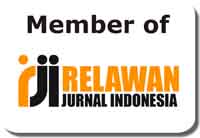The Implementation of Blended Learning in English for Arts Education Program: A Case Study
Abstract
Keywords
Full Text:
PDFReferences
Alebaikan, R., & Troudi, S. (2010). Blended learning in Saudi universities: Challenges and perspectives. ALT-J: Research in Learning Technology, 18(1), 49–59. https://doi.org/10.1080/09687761003657614
Anthony, B., Kamaludin, A., Romli, A., Raffei, A. F. M., Phon, D. N. A. L. E., Abdullah, A., & Ming, G. L. (2020). Blended Learning Adoption and Implementation in Higher Education: A Theoretical and Systematic Review. In Technology, Knowledge and Learning (Issue 0123456789). Springer Netherlands. https://doi.org/10.1007/s10758-020-09477-z
Behjat, F. (2013). Internet-supplemented ESP Coursebooks: Fostering Iranian ESP Students’ Vocabulary Breath. Procedia - Social and Behavioral Sciences, 93(2001), 1755–1759. https://doi.org/10.1016/j.sbspro.2013.10.111
Bliuc, A. M., Ellis, R. A., Goodyear, P., & Piggott, L. (2011). A blended learning approach to teaching foreign policy: Student experiences of learning through face-to-face and online discussion and their relationship to academic performance. Computers and Education, 56(3), 856–864. https://doi.org/10.1016/j.compedu.2010.10.027
Boddy, C., Detellier, C., Duarte, S., Duplàa, E., Erdmer, A., Levasseur, D., Mckay, M., & Ufholz, L. (2013). Report of the E-Learning Working Group. University of Ottawa, March, 82.
Creswell, J. W. (2014). Research Design: Qualitative, Quantitative, and Mixed Methods Approaches. Thousand Oaks: SAGE Publications, Inc.
Dias, S. B., & Diniz, J. A. (2012). Blended learning in higher education: Different needs, different profiles. Procedia Computer Science, 14(Dsai), 438–446. https://doi.org/10.1016/j.procs.2012.10.050
Dja’far, V. H., Cahyono, B. Y., & Bashtomi, Y. (2016). EFL Teachers’ Perception of University Students’ Motivation and ESP Learning Achievement. Journal of Education and Practice, 7(14), 28–37. http://ezproxy.lib.utexas.edu/login?url=http://search.ebscohost.com/login.aspx?direct=true&db=eric&AN=EJ1102990&site=ehost-live
Graham, C. R., Woodfield, W., & Harrison, J. B. (2013). A framework for institutional adoption and implementation of blended learning in higher education. Internet and Higher Education, 18, 4–14. https://doi.org/10.1016/j.iheduc.2012.09.003
Hande, S. (2014). Strengths weaknesses opportunities and threats of blended learning: Students′ perceptions. Annals of Medical and Health Sciences Research, 4(3), 336. https://doi.org/10.4103/2141-9248.133455
Hofmann, J. (2011). Top 10 Challenges of Blended Learning. Soapbox, April, 12–13.
Holley, D., & Oliver, M. (2010). Student engagement and blended learning: Portraits of risk. Computers and Education, 54(3), 693–700. https://doi.org/10.1016/j.compedu.2009.08.035
Hubackova, S. (2015). Blended Learning – New Stage in the Foreign Language Teaching. Procedia - Social and Behavioral Sciences, 197(February), 1957–1961. https://doi.org/10.1016/j.sbspro.2015.07.582
Kaur, M. (2013). Blended Learning - Its Challenges and Future. Procedia - Social and Behavioral Sciences, 93, 612–617. https://doi.org/10.1016/j.sbspro.2013.09.248
Khlaisang, J., & Likhitdamrongkiat, M. (2015). E-learning System in Blended Learning Environment to Enhance Cognitive Skills for Learners in Higher Education. Procedia - Social and Behavioral Sciences, 174, 759–767. https://doi.org/10.1016/j.sbspro.2015.01.612
Lungu, I. (2013). The Increasing Need for Blended-learning Models in Courses of English for Specific Courses in Romanian Universities. Procedia - Social and Behavioral Sciences, 76, 470–475. https://doi.org/10.1016/j.sbspro.2013.04.148
Marwan, A. (2017). Esp Teaching Challenges in an Indonesian Vocational Higher Institution. The English Teacher, 38, 1–12.
Moskal, P., Dziuban, C., & Hartman, J. (2013). Blended learning: A dangerous idea? Internet and Higher Education, 18, 15–23. https://doi.org/10.1016/j.iheduc.2012.12.001
Paechter, M., & Maier, B. (2010). Online or face-to-face? Students’ experiences and preferences in e-learning. Internet and Higher Education, 13(4), 292–297. https://doi.org/10.1016/j.iheduc.2010.09.004
Pavla, S., Hana, V., & Jan, V. (2015). Blended Learning: Promising Strategic Alternative in Higher Education. Procedia - Social and Behavioral Sciences, 171, 1245–1254. https://doi.org/10.1016/j.sbspro.2015.01.238
Poedjiastutie, D. (2017). The Pedagogical Challenges of English for Specific Purposes (ESP) Teaching at the University of Muhammadiyah Malang, Indonesia. Educational Research and Reviews, 12(6), 338–349.
Poon, J. (2014). A cross-country comparison on the use of blended learning in property education. Property Management, 32(2), 154–175. https://doi.org/10.1108/PM-04-2013-0026
Prohorets, E., & Plekhanova, M. (2015). Interaction Intensity Levels in Blended Learning Environment. Procedia - Social and Behavioral Sciences, 174(3822), 3818–3823. https://doi.org/10.1016/j.sbspro.2015.01.1119
Rahman, N. A. A., Hussein, N., & Aluwi, A. H. (2015). Satisfaction on Blended Learning in a Public Higher Education Institution: What Factors Matter? Procedia - Social and Behavioral Sciences, 211(September), 768–775. https://doi.org/10.1016/j.sbspro.2015.11.107
Ramakrisnan, P., Yahya, Y. B., Hasrol, M. N. H., & Aziz, A. A. (2012). Blended Learning: A Suitable Framework For E-Learning In Higher Education. Procedia - Social and Behavioral Sciences, 67, 513–526. https://doi.org/10.1016/j.sbspro.2012.11.356
Richards, J. C., & Schmidt, R. (2010). Longman Dictionary of Language Teaching & Applied Linguistics, Fourth Edition. In Great Britain: Pearson Education Limited.
Smyth, S., Houghton, C., Cooney, A., & Casey, D. (2012). Students’ experiences of blended learning across a range of postgraduate programmes. Nurse Education Today, 32(4), 464–468. https://doi.org/10.1016/j.nedt.2011.05.014
Yalçınkaya, D. (2015). Why is Blended Learning for Vocationally Oriented Language Teaching? Procedia - Social and Behavioral Sciences, 174, 1061–1068. https://doi.org/10.1016/j.sbspro.2015.01.795
Yin, R. (2014). How to Know Whether and When to Use the Case Study As a Research Method. In Case Study Research Design and Methods (p. 1–25).
DOI: http://dx.doi.org/10.31332/lkw.v0i0.2169
Copyright (c) 2020 Nindya Primandita Kristianingrum

This work is licensed under a Creative Commons Attribution-ShareAlike 4.0 International License.
Langkawi: Journal of The Association for Arabic and English indexed by:



















.png)
.png)

.png)
2.png)








